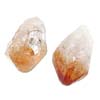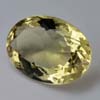- sale
- new items
- lovely beads
- wedding beads
- beads for teens
- for custom order
- newsletter
- recognition
- testimonials
- birthstones
- zodiac signs
- jewelry guide
SHOP BAG
![]() in your bag 0 items
in your bag 0 items
Citrine is a transparent, coarse-grained variety of the mineral quartz. It is a semiprecious gem that is valued for its yellow to brownish color and its resemblance to the rarer topaz. The name "citrine" is derived from the French word for lemon - CITRON. Citrine is actually somewhat rare in nature, most citrines on the market have been heat treated. Specimens of low grade, inexpensive amethyst or smoky quartz are often cooked at high temperatures to produce the more profitable orange yellow citrine. Citrines whose colors have been produced by artificial means tend to have much more of an orange or reddish caste than those found in nature, which are usually a pale yellow.
Unfortunately for citrine it is itself often confused with the more expensive orange-yellow topaz and is at times sold as topaz by unscrupulous dealers. This practice has soured many potential citrine fanciers who see citrine as a fake topaz and not as a legitimate gemstone. Natural citrine is often used in rings or pendants; less attractive gemstones are often made into necklaces. Citrine can naturally form together with amethyst making a bi-colored gemstone known as ametrine. Ametrine can be also made by heating an amethyst until it turns into citrine, then irradiating a part of the resulting crystal or gemstone to convert that portion back to amethyst. If left in sunlight for many hours a citrine will permanently change its coloring.
Ancient cultures believed that placing a Citrine Gemstone on the forehead of an elder would increase his psychic power. This lovely yellow jewel is also known as the lucky merchants stone and if placed in the cash drawer it will help the money flow by increasing sales. Citrine is often given as a symbol of hope, youth, health and fidelity. Soldiers in Caesar's legions are said to have worn Citrine on the chest during battle making use of the Gemstones life-saving properties.
Natural citrine is not common and occurs sparingly in many large quartz deposits. Most material comes from Minas Gerais, the state of Rio Grande do Sul, Brazil, but almost all of the Brazilian material is heat-treated amethyst. Natural deposits of citrine are also found in Argentina, Brazil, Madagascar, Myanmar, Namibia, Scotland, Spain, in the Ural Mountains of Russia, and in Dauphine, France. California within the United States is another good source.



